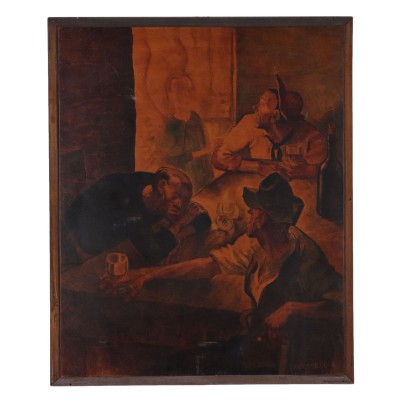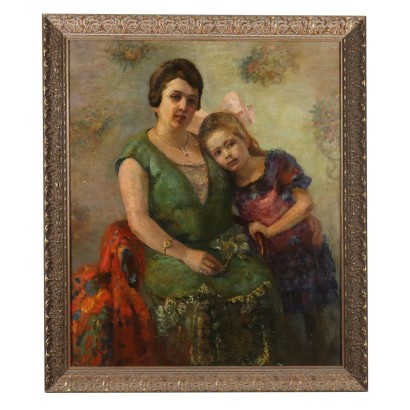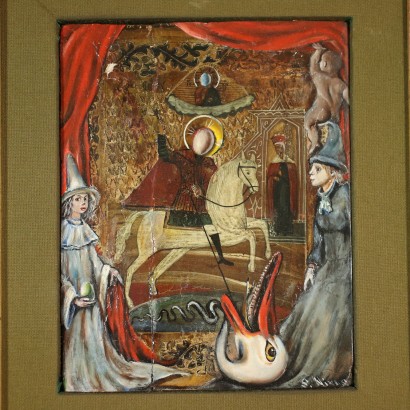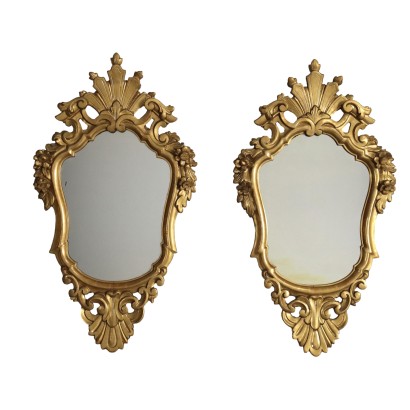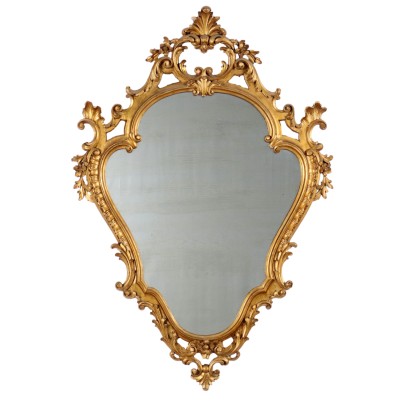Modern Painting Signed B. Porcheddu Mixed Technique Italy 1942 - Three Drinkers and an Angel 1942
Features
Three Drinkers and an Angel 1942
Artist: Giuseppe Porcheddu (1898-1947)
Artwork title: Tre bevitori e un angelo
Age: 20th Century / 1901 - 2000
Subject: Scene with Figures
Artistic technique: Painting
Technical specification: Mixed technique on board
Description : Tre bevitori e un angelo
Mixed media on board. Signed lower right. On the back further signature, title and date. Beppe Porcheddu, an important Italian illustrator and ceramist, was also a painter. In his evolutionary artistic path "it would seem that the artist has poured "the illustrator" into the painter and vice versa "the painter has prevailed in the illustration". From his first production, alongside his aptitude for the grotesque, Porcheddu showed a natural inclination for what was defined as a "perfect trio of symbols of a world (the medieval one) that expressed itself through metaphors like no other previous civilization" . In this panel, that tendency towards the grotesque is well expressed in the figures of the three drinkers, presented with crude features, clear lines and marked angles, while the figure of the angel appears evanescent, blurred, framed in the single light that comes from the open door.
Product Condition:
Product in good condition, has small signs of wear. We try to present the real state as fully as possible with photos. If some details are not clear from the photos, what is stated in the description applies.
Artwork dimensions (cm):
Height: 60
Width: 50
Depth: 3,5
Additional Information
Artist: Giuseppe Porcheddu (1898-1947)
Born in Turin in 1898, Giuseppe (Beppe) Porcheddu attended drawing courses in the architecture faculty of the Polytechnic of Turin. Self-taught, Porcheddu was an Italian illustrator, ceramist and painter, master of Italian illustration and graphics from the 1920s to the 1940s. He illustrated literary works for various publishers including Treves, Paravia, De Agostini with a particular predilection for those aimed at children such as "Il Corriere dei Piccoli", "Topolino", "Il Balilla". For the cinema he created the sets by Ettore Fieramosca (Alessandro Blasetti) for the comic "The Mysteries of Veiled Mirrors" together with the never published "Gulliver's Travels". In 1922 he exhibited at the Florence Book Fair; at the First Biennial of Decorative Arts in Monza, (1923); at the “Amici dell'Arte” club in Turin and at the first Roman Quadrennial (1931). Starting in 1922 he began his activity as a designer of dolls, designer of toys and decorator of ceramics which were exhibited in 1929 at the exhibition of the production of the "Lenci" factory, at the Pesaro Gallery in Milan. Among his most important works as an illustrator: “The Adventures of the Baron of Munchausen” (Paravia, 1934), and above all “The Adventures of Pinocchio” (Paravia, 1942), which remains his masterpiece, created using only three colors , brick red, baby blue and white lead, to which he added black. In "Pinocchio", the artist's graphics create a system in every single panel that still appears extraordinarily modern today. Among his most significant pictorial works: The flock, The spouses (Galleria Pesaro in Milan), Bertoldo, Artemide, Joan of Arc. In his high school years his gaze was turned to themes of more intense and profound emotional involvement. In this regard, he showed greater attention and love for the humblest figures: workers, fishermen, carpenters, farmers with gnarled hands and strongly marked faces, painted with accurate and almost crude realism. On 27 December 1947 Beppe Porcheddu left home, leaving a note to his sister: “Life is a continuous betrayal. The most beautiful dreams... remain dreams. Who knows when we'll see each other again?: no one saw him again.Age: 20th Century / 1901 - 2000
20th Century / 1901 - 2000Subject: Scene with Figures
Artistic technique: Painting
La pittura è l'arte che consiste nell'applicare dei pigmenti a un supporto come la carta, la tela, la seta, la ceramica, il legno, il vetro o un muro. Essendo i pigmenti essenzialmente solidi, è necessario utilizzare un legante, che li porti a uno stadio liquido, più fluido o più denso, e un collante, che permetta l'adesione duratura al supporto. Chi dipinge è detto pittore o pittrice. Il risultato è un'immagine che, a seconda delle intenzioni dell'autore, esprime la sua percezione del mondo o una libera associazione di forme o un qualsiasi altro significato, a seconda della sua creatività, del suo gusto estetico e di quello della società di cui fa parte.Technical specification: Mixed technique on board
Other customers have searched:
Arte Novecento, dipinti del 900, olio su tavola, pittura olio su tela, arte 800, pittura antica, arte contemporanea, quadro del '900, quadro grande, quadro olio su tela..
Se sei un appassionato d'arte, non perderti i nostri approfondimenti sul Blog Arte Di Mano in Mano e su FineArt by Di Mano in Mano - Arte:
Leggi di più
Ecco alcuni tra i principali articoli:
Vedute
Falsi nell'arte antica
Un messaggio di fiducia per ripartire
La potenza espressiva dell'arte figurativa etiope
Breve Storia del Collezionismo
Giorgio Upiglio, maestro dei libri d'artista
Matthias Withoos detto "Calzetta bianca"
San Rocco pensaci tu - Classic Monday
Ecco alcuni esempi dell'arte del Novecento più bella che puoi trovare da noi:
I Raccoglitori di patate - Lavoro estivo - Augusto Colombo, 1935
I Taglialegna - Lavoro invernale - Augusto Colombo, 1933
Il lavoro femminile, Contardo Barbieri, 1954 ca.
Sapevi che l'arte può essere anche un ottimo investimento (e non solo per grandi portafogli)?
L'Arte tra Collezionismo e Investimento
FineArt: Arte come investimento
Dai un'occhiata alle nostre rubriche di divulgazione sull'arte:
Epoche
Lavorazioni e tecniche
Mostre ed Eventi
Protagonisti
Leggi di più
Ecco alcuni tra i principali articoli:Vedute
Falsi nell'arte antica
Un messaggio di fiducia per ripartire
La potenza espressiva dell'arte figurativa etiope
Breve Storia del Collezionismo
Giorgio Upiglio, maestro dei libri d'artista
Matthias Withoos detto "Calzetta bianca"
San Rocco pensaci tu - Classic Monday
Ecco alcuni esempi dell'arte del Novecento più bella che puoi trovare da noi:
I Raccoglitori di patate - Lavoro estivo - Augusto Colombo, 1935
I Taglialegna - Lavoro invernale - Augusto Colombo, 1933
Il lavoro femminile, Contardo Barbieri, 1954 ca.
Sapevi che l'arte può essere anche un ottimo investimento (e non solo per grandi portafogli)?
L'Arte tra Collezionismo e Investimento
FineArt: Arte come investimento
Dai un'occhiata alle nostre rubriche di divulgazione sull'arte:
Epoche
Lavorazioni e tecniche
Mostre ed Eventi
Protagonisti
Product availability
The product can be seen at Cambiago
Immediate availability
Ready for delivery within 2 working days from ordering the product.



